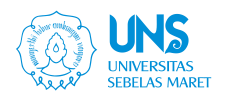Guyub Rukun Dance to Form Learning Motivation and Collaboration Ability Learners
Abstract
This study examines the integration of guyub rukun dance in elementary school learning as an effort to preserve local culture and strengthen character education. guyub rukun dance was chosen because it contains noble values such as togetherness, mutual cooperation, and social harmony that are relevant to the character formation of elementary school students. In addition, the simple dance movements and dynamic music are in accordance with the characteristics of elementary school-age students. This study uses a qualitative approach with a descriptive research type. The research data is in the form of information about the form of presentation, values, and the process of integrating guyub rukun dance in learning. Data sources include teachers, students, dance artists, and related documents. Data collection was carried out through participatory observation of the learning process, in-depth interviews with informants, photo and video documentation, and literature studies related to guyub rukun dance. Data validity was obtained through triangulation of sources, methods, and theories. The data analysis technique used the Miles and Huberman interactive model which includes data reduction, data presentation, and drawing conclusions. The results of the study indicate that the integration of guyub rukun dance is effective in: (1) increasing students' understanding of local culture, (2) developing motor skills and creativity, (3) fostering character values such as cooperation, tolerance, and responsibility, and (4) creating a fun and meaningful learning atmosphere. This study recommends the importance of integrating traditional arts in learning to preserve local culture while forming positive character in students.
Keywords
Full Text:
PDFReferences
Astuti, E. (2020). Arts and Culture in the Education Curriculum. Bandung: Alfabeta.
Creswell, J. W. (2023). Research Design: Qualitative, Quantitative, and Mixed Methods Approaches (6th ed.). SAGE Publications.
Handayani, R., & Pratiwi, S. (2022). Effectiveness of Traditional Arts-Based Learning in Increasing Elementary School Students' Learning Motivation. Journal of Elementary Education, 8(2), 112-127.
Kusuma, R. (2019). "Art Activities for Student Motivation." Journal of Art Education, 12(1), 45-57.
Kusumastuti, E. (2021). "Development of Traditional Arts Learning Model to Strengthen Character Education in Elementary Schools." Journal of Elementary Education, 12(2), 112-127.
Kusumastuti, E., & Widjajanti, D. (2024). Development of Multiple Intelligences through Traditional Arts Learning in Elementary Schools. Journal of Arts Education, 12(1), 45-60.
Nugroho, A., & Setiawati, R. (2022). "The Effectiveness of Traditional Arts-Based Learning in Improving Elementary School Students' Social Skills." Journal of Arts Education, 8(1), 45-58.
Nugroho, D. (2020). Philosophy of Javanese Traditional Art. Yogyakarta: Kanisius.
Presidential Regulation of the Republic of Indonesia Number 87 of 2017 concerning Strengthening Character Education.
Minister of Education and Culture Regulation Number 20 of 2018 concerning Strengthening Character Education in Formal Education Units.
Pramono, A., Sutikno, R., & Wibowo, H. (2023). Implementation of Traditional Arts-Based Learning to Strengthen Elementary School Students' Character. Journal of Educational Innovation, 9(1), 78-93.
Prasetyo, H. (2022). "The Effectiveness of Traditional Dance in Character Education." Scientific Journal of Character Education, 10(2), 34-50.
Pratiwi, S. (2023). "Challenges and Opportunities for Implementing Traditional Arts-Based Learning in the Digital Era." Journal of Educational Innovation, 9(2), 78-92.
Rahman, F. (2021). "The Role of Traditional Dance in Character Formation of Students: Case Study in Elementary Schools." Journal of Character Education, 7(1), 23-36.
Rahmawati, N., & Sulistyo, B. (2024). The Dual Role of Traditional Dance in Character Education and Cultural Preservation. Journal of Cultural Studies, 11(1), 23-38.
Suryadi, A. (2021). Traditional Arts-Based Education. Jakarta: Pustaka Cendekia.
Suryani, N. (2023). "Multiple Benefits of Traditional Arts Integration in Elementary Education.” International Journal of Education and Culture, 15(3), 245-260.
Sutrisno, A., & Wardani, K. (2023). Traditional Arts Learning Model for the Digital Generation. Journal of Educational Technology, 10(2), 156-171.
Law of the Republic of Indonesia Number 20 of 2003 concerning the National Education System.
Utami, L. (2021). Cultural Identity in the Era of Globalization. Surakarta: UNS Press.
Wardani, E., & Nugroho, A. (2022). Revitalization of Traditional Arts through Digital Technology. Journal of Educational Media, 7(3), 201-216.
Widiastuti, A. (2023). Ethnographic Study of Traditional Dance in the Context of Modern Education. Journal of Educational Anthropology, 6(2), 89-104.
Widodo, A., Suharto, S., & Prasetyo, Y. (2020). "Analysis of Elementary School Students' Understanding of Local Culture in the Digital Era." Indonesian Journal of Elementary Education, 5(1), 12-25.
Wijaya, T. (2021). "Collaboration in Dance Arts." Journal of Nusantara Culture, 15(3), 78-89.
Winarno, S., & Sutanto, T. (2024). Integration of Local Wisdom Values in 21st Century Learning. Journal of Character Education, 13(1), 67-82.
Yulianti, D., & Santoso, B. (2023). Optimizing Culture-Based Learning in the Digital Era. Journal of Learning Innovation, 8(4), 178-193.
Zulkarnain, R., & Permana, H. (2022). Transformation of Traditional Arts Learning in the Society 5.0 Era. Journal of Learning Technology, 9(1), 34-49
Refbacks
- There are currently no refbacks.











